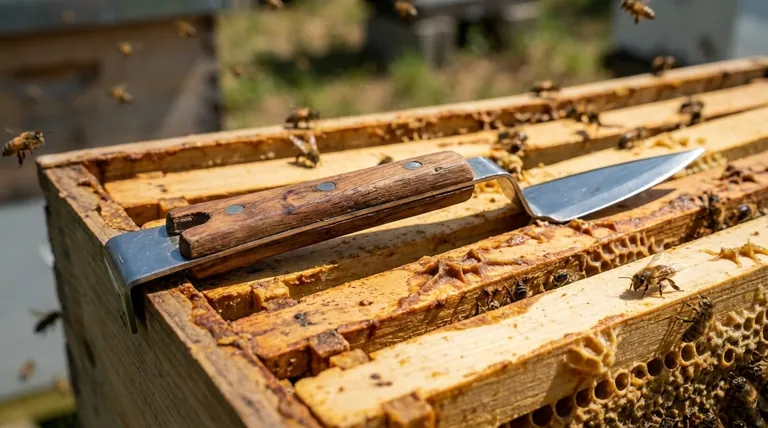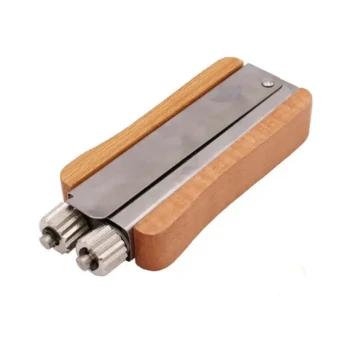The primary benefit of a multi-functional hive tool is its ability to consolidate the functions of several specialized instruments into a single, efficient device. By combining features like a flat blade for prying, a hook for lifting frames, and a serrated edge for cutting, it allows a beekeeper to perform a wide range of tasks without ever needing to switch tools, saving valuable time and effort during hive inspections.
The true advantage of a multi-functional hive tool isn't just versatility; it's about streamlining the entire beekeeping workflow. It transforms a collection of separate actions into a fluid, uninterrupted process, minimizing disturbance to the colony and maximizing the beekeeper's efficiency.

Beyond Prying: Core Inspection Functions
A standard hive tool is excellent for prying and scraping, but a multi-functional tool integrates additional capabilities that are essential for a thorough inspection.
Frame Lifting and Spacing
The most common feature is a "J-hook" or "L-hook" end. This provides critical leverage to lift propolis-sealed frames straight up, reducing the jarring, rolling motions that can anger or crush bees.
Efficient Cleaning
While any tool can scrape, specific modifications enhance cleaning. The sharp, flat edge is perfect for removing excess burr comb and propolis from frames and hive bodies. Some designs even include features specifically for cleaning charred debris from the inside of a smoker lid.
Detailed Brood Management
A modified, sharpened tip can be used to gently uncap individual worker or drone brood cells for pest inspection. This allows for a more delicate and precise action, causing significantly less damage to the surrounding comb compared to a blunter instrument.
Specialized Tasks Made Simple
The value of a multi-functional tool becomes most apparent when performing tasks that go beyond a routine inspection, particularly when installing new bees or managing equipment.
Installing New Bee Packages
A multi-functional tool excels at installing packages. Its features can be used to pry open the package, get under the rim of a sugar syrup can for easy removal, and efficiently pull the staple holding the queen cage in place.
Managing Queen Cages and Feeders
The fine point of a modified tool is ideal for uncorking a queen cage without damaging it. That same tip can be used to precisely puncture holes in the lids of feeding jars, ensuring a proper feeding rate.
General Apiary Maintenance
Some tools include a sharpened notch or serrated edge. This is surprisingly useful for cutting away overgrown vines near a hive entrance or cutting lengths of rope or baling twine in the apiary.
Understanding the Trade-offs
While highly effective, the multi-functional design is not without its considerations. Objectivity requires acknowledging where a specialized tool might be preferred.
The Jack-of-All-Trades Dilemma
A tool designed to do everything may not do every single task as perfectly as a dedicated instrument. For example, a beekeeper who struggles with hand strength might find a separate, dedicated frame lifter offers superior leverage compared to the J-hook on a multi-tool.
Ergonomics and Personal Preference
The feel of a tool is highly personal. Some experienced beekeepers simply prefer the simplicity, weight, and balance of a traditional American or Italian-style hive tool they have used for years. The added features can sometimes feel bulky to a user accustomed to a minimalist design.
Making the Right Choice for Your Goal
Selecting a hive tool depends entirely on your beekeeping philosophy and the tasks you perform most often.
- If your primary focus is efficiency and carrying minimal gear: The multi-functional hive tool is the definitive choice, consolidating your entire toolkit into one.
- If you frequently install new packages or manage nucs: The specialized features for uncorking cages and removing staples offer a clear and significant advantage.
- If you value simplicity and dedicated tools for specific jobs: A traditional flat tool remains an excellent, robust option, supplemented by other specialized tools as needed.
Ultimately, the best hive tool is the one that becomes a seamless extension of your hand, simplifying your work and promoting calm, effective hive management.
Summary Table:
| Function | Traditional Tool | Multi-Functional Tool |
|---|---|---|
| Prying & Scraping | ✓ | ✓ |
| Frame Lifting (J-Hook) | (Separate tool) | ✓ |
| Cutting & Uncapping | (Separate tool) | ✓ |
| Queen Cage/Feeder Tasks | (Separate tools) | ✓ |
| Gear to Carry | Multiple tools | One tool |
Ready to upgrade your apiary's efficiency? As a leading wholesale supplier to commercial apiaries and distributors, HONESTBEE provides durable, high-performance hive tools designed for heavy-duty use. Our multi-functional tools are built to streamline your operations, reduce equipment costs, and save valuable time during hive inspections. Let us equip your business for success. Contact HONESTBEE today to discuss wholesale pricing and our full catalog of beekeeping supplies.
Visual Guide

Related Products
- HONESTBEE Premium Italian Style Hive Tool with Hardwood Handle
- HONESTBEE Advanced Ergonomic Stainless Steel Hive Tool for Beekeeping
- HONESTBEE Professional Long Handled Hive Tool with Precision Cutting Blade
- Professional Multi-Function Stainless Steel Hive Tool
- HONESTBEE 15-in-1 Beekeeper Multi-Tool with Hammer and Pliers for Beekeeping
People Also Ask
- What is required for regular inspections in both Flow Hives and Langstroth hives? Essential Beekeeping Tasks Explained
- What is a hive tool and why is it important in beekeeping? The Essential Key to Hive Management
- Is it advisable to manage a large number of hives alone? The Risks of Solo Beekeeping at Scale
- What are some common uses of a hive tool? Essential Multi-Purpose Tool for Every Beekeeper
- What maintenance steps are recommended for hive tools? Ensure Longevity & Apiary Health



















